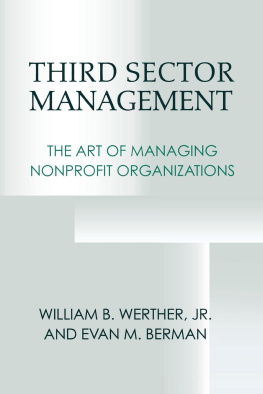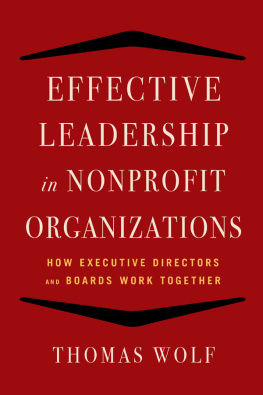Third Sector Management
Third Sector
Management
The Art of Managing
Nonprofit Organizations
William B. Werther, Jr.
and
Evan M. Berman
Georgetown University Press, Washington, D.C.
2001 by Georgetown University Press. All rights reserved.
Printed in the United States of America
10 9 8 7 6 5 4 3 2001
This volume is printed on acid-free offset book paper.
Library of Congress Cataloging-in-Publication Data
Werther, William B.
Third sector management : the art of managing nonprofit organizations / by William B. Werther, Jr., and Evan Berman.
p. cm.
Includes bibliographical references and index.
ISBN 978-0-87840-843-6 (cloth : alk. paper)ISBN 978-0-87840-844-3 (pbk. : alk. paper) 1. Nonprofit organizationsManagement. I. Title: 3rd sector management. II. Berman, Evan M. III. Title.
HD 62.6. W47 2001 658.048dc21 |
00-061024 |
This book is lovingly dedicated to
my son, Bill, his wife, Mari, and their children,
Chase and Hunter Werther (WBW),
and to
my wife, Dira, and daughter,
Daniella Celine Berman (EMB).
Contents
About the Authors
William B. Werther, Jr., Ph.D., is the codirector of the Center for Nonprofit Management and Office Depot Management Scholar at the University of Miami. He also is a past chair for the Managerial Consultation Division of the Academy of Management, Fellow and past chair of the International Society for Productivity and Quality Research, and Fellow in the World Academy of Productivity Science. Teaching and research interests include corporate strategy, technology, and their human resource implications.
He has earned multiple teaching awards and is an award-winning author. Human Resources and Personnel Management, 5th edition (McGraw-Hill, 1996), and Dear Boss (Simon and Schuster/Meadowbrook, 1989) are two of his many books. Besides books translated into nine languages, he has authored more than 80 articles for California Management Review, Organizational Dynamics, and other journals. Service includes editorial board memberships for the National Productivity Review, Health Care Management, and the Journal of Management Development, for which he served as North American editor.
His experience includes work for the White House Conference on Productivity, NASA, the American Productivity and Quality Center, and scores of other nonprofits in health care, education, arts, community development, religion, and philanthropy. An experienced labor arbitrator, he chaired the Public Employment Relations Board for the City of Phoenix from 1980 to 1982. In Miami, community service includes a gubernatorial appointment to the International Currency and Barter Exchange Committee, the Executive Committee of Leadership Miami, and service on other nonprofit boards. His expertise has been sought by more than 100 organizations in Europe and the Americas, including the White House, the U.S. House of Representatives, Arizona State Senate, Fortune, Wall Street Journal, U.S. News and World Report, and Nations Business.
He earned a Ph.D. (Phi Beta Kappa) from the University of Florida in 1971; then became a professor of management at Arizona State University for 14 years. In addition, he has taught at the Universidade do Porto (Portugal), the Universidad Autonoma Guadalajara (Mexico), and the Universidad Gabriela Mistral (Chile), where he serves as a visiting professor each spring.
Evan M. Berman, Ph.D., is associate professor of Public Administration at the University of Central Florida (Orlando) and teaches in the schools Ph.D. Program in Public Affairs. His experience includes numerous seminars to nonprofit and public managers on organizational improvement, strategy, and productivity. He is a member of the American Society for Public Administration and past chair of its section on Personnel and Labor Relations. He has worked for the National Science Foundation and has served as a consultant to U.S. Congress and the National Academy of Sciences.
He has received teaching and research awards and is a leading scholar on productivity improvement in public and nonprofit organizations. He has published more than 75 articles and several books on these topics, including HRM in Public Organizations (Sage, 2001), The Ethics Edge (ICMA, 1998), and Productivity in Public and Nonprofit Organizations (Sage, 1998). His research has been published in such journals as Journal of Urban Affairs, Policy Studies Review, and Public Administration Review. He has also done extensive research on community-based planning involving public and nonprofit organizations addressing important social problems. His work has been presented in foreign settings and translated in foreign languages.
Educated in Europe and the United States, he received his Ph.D. from George Washington University in 1988 in the area of public policy. Before joining the faculty at the University of Central Florida, he was on the faculty at the University of Miami.
Preface
Why do some nonprofit organizations succeed and others fail? How can leaders of nonprofits increase the likelihood of success? Why is a strategic viewpoint central to building a viable nonprofit?
This book answers these and other key questions from a strategic perspective, which assumes vision, mission, strategy, and execution are pillars on which success is built. addresses the execution of the strategic perspective through productivity, performance measurement, alliance building, and fundraising.
Although many third sector practitioners and researchers might argue that the single key to success is fundraising, we believe that fundraising depends on how the nonprofit is positioned and performs. Though the demands for the services provided by many nonprofits are seemingly unending, the resources available to accomplish their roles are always finite. Whether arts, education, health care, religious, philanthropic, or other nonprofit organizations, they seldom have sufficient funds to deliver all the services desired by constituents. Because there are many worthy nonprofits, why should donors, volunteers, or others contribute to one particular nonprofit versus another? Restated, how does a nonprofit distinguish itself from others?
Positioning depends on a blend of perception and practices. Does the nonprofit present a vision of the future that is both ennobling and inspiring to donors, volunteers, staff, and other constituents? Is the mission of the nonprofit well-defined and focused? Bluntly put, why should anyone but recipients care about the organization, its vision and mission? Even if the vision and mission of the nonprofit are attractive, how well does the nonprofit perform? Does it have high productivity? Solid performance outcomes and measures? Are the good deeds done by the nonprofit communicated, understood, and appreciated by constituents within and outside the nonprofit? How successful is the nonprofit in building bridges to the private and public sectors? Ultimately, perceptions and performance form a foundation that shapes the success of fundraising, the lifeblood of the nonprofit.









